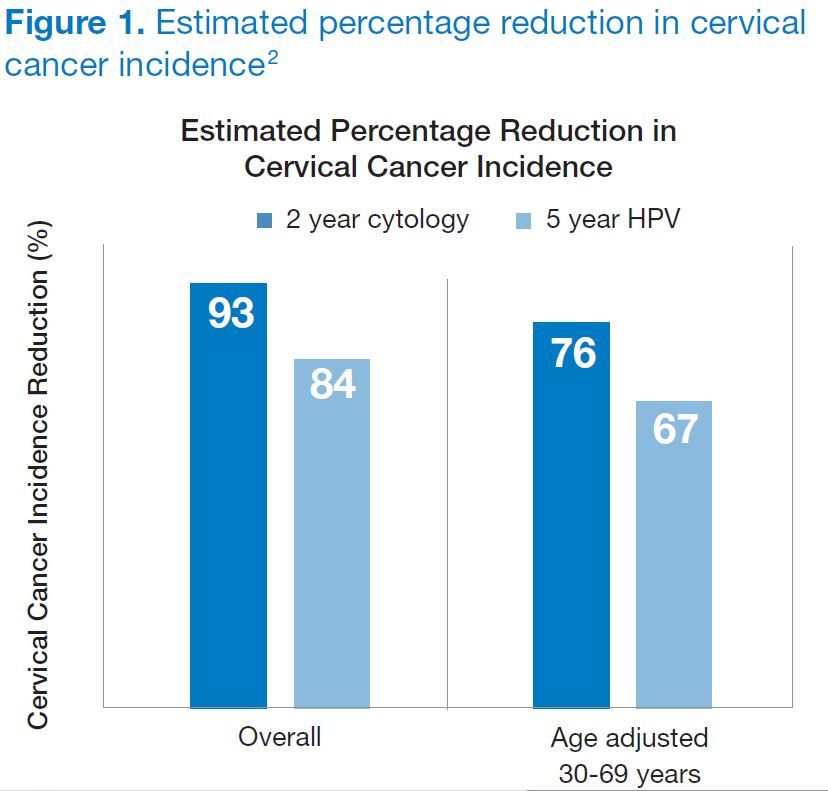Cervical cancer screening in Australia: A new policy may undermine prevention
Sponsored Content

Partner Perspectives
Sponsored by: Hologic
Beginning in December 2017, the Australian Government implemented changes in its National Cervical Screening Program (NCSP). These changes came from an assessment of potential screening pathways, tests, and intervals called the Renewal.1 Previously, women between the ages of 18 and 70 years were screened for cervical cancer using a cytologic (Papanicolaou [Pap]) test every 2 years. These changes, however, meant shifting to human papillomavirus (HPV) testing alone every 5 years, including for women as young as age 25 years. A study by Cox and Sneyd to estimate the impact of the changes on cancer prevention predicted an increase in the incidence rate of cervical cancer with primary HPV screening every 5 years compared with prior cytologic screening methodology.2 In addition, the study predicted this Renewal policy would result in cervical cancer overdiagnosis, increase unnecessary colposcopy referrals, and delay reporting results to patients. In this report, we review findings from that study and discuss their relevance to cervical cancer screening strategies in the United States based on recent evidence that shows potential harmful consequences for women derived from the Australian experience.
Renewal policy of the Australian National Cervical Screening Program
The Renewal policy of the Australian NCSP represents a valuable opportunity to assess the true impact of adopting HPV testing alone every 5 years.1 The policy was based on simulation models that do not accurately reflect the impact HPV testing every 5 years may have on public health in Australia.2 The models used detection sensitivity, defined as the probability that a test will detect its target: cervical intraepithelial neoplasia (CIN). The potential for HPV testing to preferentially detect nonprogressive CIN was not assessed, however, and would require measurement of cervical cancer incidence between screening events. The simulation models assumed that HPV testing has greater screening sensitivity than cytology based on the probability that the test detects the subset of disease that will progress to life-threatening invasive cancer when it is present and that reliance on HPV testing will decrease cervical cancer incidence and mortality. Mere HPV detection does not predict the fate of an infection, ie, whether it will spontaneously resolve, cause a cancer lesion, or persist with no clinical consequences. Not distinguishing among these outcomes hinders accurate prediction of the likelihood of cancer.
Risk of increasing cervical cancer incidence
Several clinical studies have compared HPV testing with cytology screening, yielding mixed results.3–7 A rigorous analysis was conducted to determine the relative impacts of HPV testing and cytology on public health using results from an earlier randomized health services study on cervical cancer screening in Finland.2,5 This study did not introduce the analytic bias of excluding women previously diagnosed with CIN detected by cytology, which reduces the potential pool of cytology-detectable lesions prior to randomization, thus biasing the comparison against cytologic screening.
Cytologic screening and primary HPV testing were evaluated in the context of well-accepted estimates of the effects of screening frequencies on cervical cancer incidence combined with published age-specific data on the frequency with which women are actually screened. The study showed that women age 30 to 64 years screened under the prior (every 2 years) cytologic protocol would be expected to have a cervical cancer incidence of 7.5% relative to the 100% incidence expected in unscreened women.2 Anticipated reductions in cervical cancer risks with cytology every 2 years and HPV testing every 5 years would be approximately 93% and 84%, respectively (Figure 1).2 Thus, the risk of cervical cancer would increase with the new HPV testing protocol versus the prior cytology screening program.
Figure 1.

Women differ in their adherence to screening protocols. Based on data from the Australian NCSP, 17% of Australian women age 20 years and older had not been screened in the previous 5 years or had never been screened.1,2 The estimated proportions without screening or with more than 10 years between screening tests varied significantly by age: from 9% to 16% in women age 30 to 54 years and from 21% to 34% in those age 55 to 69 years. When applying the relative protection from screening to the different screening frequencies of different age groups, the cervical cancer risks for women age 30 to 69 years were reduced by only 67% with HPV testing every 5 years versus 76% with cytologic screening every 2 years.2
The overall incidence of cervical cancer in women in Australia was predicted to increase by 39% with HPV testing every 5 years versus cytologic screening every 2 years as a result of screening inadequacy.2 This translates to an additional 222 women developing cervical cancer each year for the next 10 years. For relatively screening-compliant women with less than 10 years since their last negative test, the new HPV testing protocol was predicted to increase the annual incidence of cervical cancer in women screened to 121% of that attained with the prior cytologic screening protocol. Even if the new protocol resulted in a 10% increase in the proportion of women screened, the overall incidence of cervical cancer in Australia would be expected to rise 30% due to screening inadequacy. Based on these figures, the transition to the HPV testing protocol would be detrimental to women in the absence of better evidence of at least equivalent public health outcomes.
Overdiagnosis and treatment delays
The Renewal policy includes HPV testing in women age 25 to 69 years and is based on high estimates of detection sensitivity.8 Because the vast majority of HPV infections regress spontaneously within 2 years, the increased sensitivity of HPV testing would amount to overdiagnosis, which in turn would result in overtreatment (ie, use of colposcopies).2 The study findings suggest that this overtreatment would increase the treatment burden on women who would not have ultimately progressed to invasive cancer.2
It is important to note that since implementation of the Renewal policy, a colposcopy clinic in Australia reported that the volume of referrals has increased sixfold.9 This increase likely stems from increased sensitivity of the HPV test combined with its inability to predict which lesions will progress to cancer. The increased colposcopy volume prolonged the waiting times for women to be seen in the colposcopy clinic to approximately 12 months. Overdiagnosis and unnecessary colposcopies and biopsies could harm a woman’s fertility or ability to carry a child to term.10
These findings should prompt additional research to further evaluate the success of various screening protocols at providing protection against cervical cancer. Based on lack of conclusive evidence on the most protective screening program, it would be advisable to implement a cotesting screening protocol, during which time the information lacking to assess the effectiveness of HPV testing on reducing cervical cancer compared with the prior cytologic protocol could be collected. The findings of the study analysis do not support lengthening the cervical cancer screening interval, especially in conjunction with a change in testing method.2
Identifying a preferred screening option for cervical cancer
Human papillomavirus testing is often used as an adjunct to cytologic screening, a strategy known as cotesting.8 A debate is currently under way as to the best method for cervical cancer screening. Screening with an HPV test alone was shown to be less effective than cotesting in the largest real-world retrospective study, showing that 1 of 5 cases of cervical cancer were missed with HPV screening alone.11
Joint guidelines from the American Society for Colposcopy and Cervical Pathology, American Society for Clinical Pathology, and American Cancer Society issued in 2012 recommend cytologic screening every 3 years in women younger than age 30 years and cytologic screening every 3 years or with cotesting every 5 years in women age 30 years and older.12 Cotesting is the preferred method, and HPV testing alone every 5 years is discouraged. Subsequent 2016 guidance from the American College of Obstetricians and Gynecologists also recommends cotesting as the preferred screening method.13 More recently in 2018, the US Preventive Services Task Force endorsed cytologic screening every 3 years, HPV testing every 5 years, and cotesting as acceptable options.14
Implications for US screening
The Renewal policy was partially driven by the high HPV vaccine uptake in Australia relative to most countries, including the United States.15 Human papillomavirus testing is most efficacious in screening cohorts with complete HPV vaccine coverage.16 HPV infection occurs primarily in young adulthood, however, and vaccination after infection does not reduce risk of cervical cancer. Therefore, vaccination will provide no reduction in risk for most women currently age 30 years or older. Cotesting is the best test method in populations of variable vaccine uptake across all age groups.13 Unvaccinated women who are screened with the HPV test tend to have more “false positives” versus those screened with cotesting.17
Despite differences in healthcare programs between the United States and Australia, which has a universal healthcare system, the cervical cancer incidence rates are comparable.18,19 For Australia, the 2015 age-adjusted incidence rate for cervical cancer was 6.9 cases/100,000 women per year.18 For the United States, the 2012–2017 age-adjusted incidence rate of cervical cancer was 7.3 cases/100,000 women per year.19 These incidence rates suggest that similar factors may influence success in cervical cancer screening between the two countries and that lessons learned from the Australian experiment can provide cautionary guidance.
Other factors that could limit the efficacy of HPV screening should be considered in addition to increased colposcopies and the associated costs demonstrated in the Australian study.20 There is currently a lack of healthcare provider support in the United States for HPV primary screening because the impact on clinical practice has not been rigorously studied. For example, the psychosocial impact of HPV screening on cervical cancer prevention is not understood.21 Changes in clinical practice and screening strategy would require significant investment in patient reeducation and may negatively affect testing compliance, which would contribute to increased cervical cancer incidence.
Based on the study analysis of Australia’s Renewal policy, findings from previous studies, as well as concerning implications for both healthcare providers and patients, adoption of HPV testing alone every 5 years is not advisable in any country, including the United States. The current accepted strategy of cytology for women age 21 to 29 years and cotesting for those age 30 to 65 years should continue to ensure the best possible protection and compliance among both healthcare providers and their patients, and ultimately guarantee what is best for women.
Note: The study on HPV screening, invasive cervical cancer, and screening policy in Australia is not affiliated with Hologic and was conducted independently.

Dr. Brian Cox is a medical epidemiologist and public health physician with specific training in cancer screening and epidemiology. He was also the New Zealand representative to the International Cancer Screening Network of the National Cancer Institute for over 20 years. Dr. Cox was involved in the design and establishment of the National Cervical Screening Program (NCSP). He also established the independent monitoring groups of the national cervical and breast screening programs of New Zealand and was their inaugural chair. Dr. Cox is Director of the Hugh Adam Cancer Epidemiology Unit of the Department of Preventive and Social Medicine of the Dunedin School of Medicine.

Dr. Michael Randell is a Board-Certified Obstetrician and Gynecologist in a private practice in Atlanta, Georgia and on the Medical Staff at Emory Saint Joseph’s Hospital. He earned his Bachelor of Science degree from Emory University in Atlanta and received his Medical degree with research distinction from the University of Miami School of Medicine in Miami, Florida. Dr. Randell is an expert in laparoscopic and robotic gynecologic surgery. His research interests include managing cancer during pregnancy, the effects of barometric pressure changes on the initiation of labor, and the treatment of atypical Pap tests have led to award winning presentations at scientific meetings. Dr. Randell is a Diplomate of the American Board of Obstetrics and Gynecology and the National Board of Medical Examiners. He is also a Fellow of the American College of Obstetricians and Gynecologists.
References:
- Department of Health, Australia. National Cervical Screening Program. Available at: http://www.cancerscreening.gov.au/internet/screening/publishing.nsf/Content/cervical-screening-1. Accessed April 29, 2020.
- Cox B, Sneyd MJ. HPV screening, invasive cervical cancer and screening policy in Australia. J Am Soc Cytopathol. 2018;7(6):292–299.
- Elfström KM, Smelov V, Johansson ALV, et al. Long-term duration of protective effect for HPV negative women: follow-up of primary HPV screening randomised controlled trial. BMJ. 2014;348:g130.
- Kitchener HC, Gilham C, Sargent A, et al. A comparison of HPV DNA testing and liquid based cytology over three rounds of primary cervical screening: extended follow up in the ARTISTIC trial. Eur J Cancer. 2011;47(6):864–871.
- Malila N, Leinonen M, Kotaniemi-Talonen L, et al. The HPV test has similar sensitivity but more overdiagnosis than the Pap test-a randomised health services study on cervical cancer screening in Finland. Int J Cancer. 2013;132(9):2141–2147.
- Rijkaart DC, Berkhof J, Rozendaal L, et al. Human papillomavirus testing for the detection of high-grade cervical intraepithelial neoplasia and cancer: final results of the POBASCAM randomised controlled trial. Lancet Oncol. 2012;13(1):78–88.
- Ronco G, Dillner J, Elfström KM, et al; International HPV Screening Working Group. Efficacy of HPV-based screening for prevention of invasive cervical cancer: follow-up of four European randomised controlled trials. Lancet. 2014;383(9916):524–532.
- Marth C, Landoni F, Mahner S, et al; ESMO Guidelines Committee. Cervical cancer: ESMO clinical practice guidelines for diagnosis, treatment and follow-up. Ann Oncol. 2017;28(suppl 4):iv72–iv83.
- Sii S, Trivedi A, Wang WC. Analysis of the Peninsula Health colposcopy service data of one year since transitioning to the new cervical screening program. Obstet Gynecol Res. 2019;2(4):088–099.
- Flanagan SM, Wilson S, Luesley D, Damery SL, Greenfield SM. Adverse outcomes after colposcopy. BMC Womens Health. 2011;11:2.
- Blatt AJ, Kennedy R, Luff RD, et al. Comparison of cervical cancer screening results among 256,648 women in multiple clinical practices. [Erratum in Cancer Cytopathol. 2016;124(5):362–363.] Cancer Cytopathol. 2015;123(5):282–288.
- Saslow D, Solomon D, Lawson HW, et al; ACS-ASCCP-ASCP Cervical Cancer Guideline Committee. American Cancer Society, American Society for Colposcopy and Cervical Pathology, and American Society for Clinical Pathology screening guidelines for the prevention and early detection of cervical cancer. CA Cancer J Clin. 2012;62(3):147–172.
- American College of Obstetrics and Gynecology. Committee on Practice Bulletins-Gynecology. Practice Bulletin No. 168: Cervical cancer screening and prevention. Obstet Gynecol. 2016;128(4):e111–e130.
- US Preventive Services Task Force. Final Recommendation Statement. Cervical cancer: Screening. US Preventive Services Task Force website. Available at: https://www.uspreventiveservicestaskforce.org/Page/Document/RecommendationStatementFinal/cervical-cancer-screening2#consider. Accessed April 29, 2020.
- Bruni L, Diaz M, Barrionuevo-Rosas L, et al. Global estimates of human papillomavirus vaccination coverage by region and income level: a pooled analysis. [Erratum in Lancet Glob Health. 2017;5(7):e662.] Lancet Glob Health. 2016;4(7):e453–e463.
- Canfell K, Caruana M, Gebski V, et al. Cervical screening with primary HPV testing or cytology in a population of women in which those aged 33 years or younger had previously been offered HPV vaccination: results of the Compass pilot randomised trial. PLoS Med. 2017;14(9):e1002388.
- Rebolj M, Pribac I, Frederiksen ME, Lynge E. The problem of false-positive human papillomavirus DNA tests in cervical screening. Curr Pharm Des. 2013;19(8):1439–1449.
- Cervical cancer in Australia statistics. Available at: https://cervical-cancer.canceraustralia.gov.au/statistics. Accessed April 29, 2020.
- NIH. National Cancer Institute. Surveillance, Epidemiology and End Results Program. Cancer Stat Facts: Cervical cancer. Available at: https://seer.cancer.gov/statfacts/html/cervix.html. Accessed April 29, 2020.
- Machalek DA, Roberts JM, Garland SM, et al. Routine cervical screening by primary HPV testing: early findings in the renewed National Cervical Screening Program. Med J Aust. 2019;211(3):113–119.
- Obermair HM, Dodd RH, Bonner C, et al. ‘It has saved thousands of lives, so why change it?’ Content analysis of objections to cervical screening programme changes in Australia. BMJ Open. 2018;8(2):e019171.
